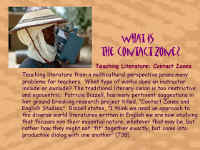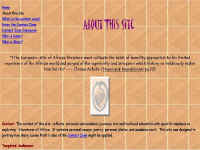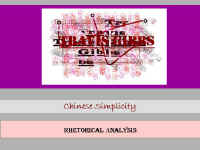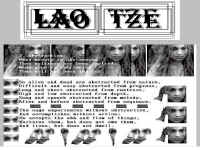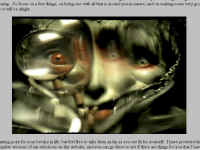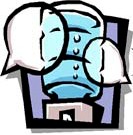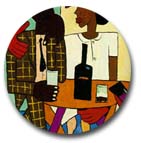
 WHAT IS THE RELATIONSHIP BETWEEN
WHAT IS THE RELATIONSHIP BETWEEN
THE INVITINGLY OPEN FORM OF WEB WRITING
AND OUR PROJECT OUTCOMES?
Part
III
|
"Form:
How can you build in the limits of form |
|
Cora's View (continued): Now I should explain that some specific formal constraints were built into web creation assignments given in Humanities 299: students were required to adhere to academic standards and copyright laws (e.g. in evaluating and citing sources), and to structure their sties in accordance with established WWW practices (e.g. creating functional index/home pages and networks of working internal navigational links, and observing "netiquette"). Although in the Spring 2001 version of Hum 299, I did standardize self-identifying information to be included in webpage footers, I did not require students to use templates. Nor did I prescribe web-genres (although several students chose to present their research findings as web-adapted annotated bibliographies-- which I recommended as an acceptable genre). Instead, Hum 299 students were given significant freedom in adapting (or creating) web genres, media, and designs deemed best suited to present their content and express their perspectives. However, this freedom of form (genre, design, media, technology) was offered within the broad, but also limiting, parameters of "Cyber Rhetoric": that is, key principles and practices for communicating effectively in "cyberspace," as I understood them. Thus, my core response to Randy Bass's "Form" questions posed above lies within my Hum 299 instruction in Cyber Rhetoric--intended to establish a framework of both opportunities and constraints for our student web-authors. In a series of hypertext essays, "Cyber
Rhetoric: A Rhetorical Approach to Writing for the World Wide Web"
(2000), I articulated my understanding of key factors and principles relevant to
effective WWW communication. As I presented my theory of genre in "Cyber
Rhetoric (3): Web Genres and Purposes," I characterized my
invitation for Hum 299 students to experiment in web genre (i.e. form) this way: |
|
"Web genres and their defining conventions are still in the process of becoming. The Internet and the World Wide Web have created new media and "domains" for communication, and new web genres have been developing to meet the needs of these new communication situations. Cyber Rhetoric scholars and teachers have only recently begun trying to categorize and describe web genres--not to mention trying to web-write and teach others how to web-write--best suited for different purposes and audiences in academic contexts. "This situation presents both drawbacks and opportunities for Hum 299 students. On the one hand, no established formula or set of hard and fast "rules" exists for communicating academic purposes to audiences effectively on the World Wide Web. As of early 2000, only a few print textbooks or online resources address such academic web-writing. In the absence of such formulas and "rules," on the other hand, Hum 299 students are freed to help shape, even invent, a Cyber Rhetoric for academic websites designed to communicate information." --"Cyber
Rhetoric (3): Web Genres and Purposes" |
|
Detour:
If you are interested in reading more |
|
Instruction in "Cyber Rhetorical" principles of
effective WWW communication became a set of (self-)assessment criteria and
guiding expectations--encompassing both freedoms and constraints, opportunities
and compromises--to be applied in students' Hum 299 websites. I asked that
students use these principles to help them analyze and assess their positive and
negative experiences as as web-researchers and users of others' websites, and to
apply these principles and the lessons of their WWW experiences to the creation
of their own websites. Hum 299 students were influenced to adopt
self-constraints on their experimentation by the reports of peer, instructor,
and outsiders' reviews of student websites built into the course. In
addition, Hum 299 students were required to conduct and publish cyber-rhetorical
analyses of their web sites, identifying, and considering the relationships
among, their topic interests, research findings, website purposes, intended
audiences, and chosen genres. This self-reflective exercise helped
students detect consonance and dissonance in the interplay and effects of their
various website elements (i.e. content and form).
How well form and content worked together--especially to achieve student web-authors' stated purposes with targeted audiences--became a central criterion that Cora used in evaluating Hum 299 student web sites. |
|
How
well to you think . . . (Before you review, however, please see our Notes on Form.) |
Exploring
the Contact Zone:
A Personal Journey Through
Multicultural Education (Spring 2000)
http://www.cocc.edu/hum299/hendrix/index.html
Chinese
Simplicity
(Spring 2001)
http://www.cocc.edu/hum299/gibbs/index.html
. . .
and/or make your own
selections for review and discussion from:
Showcase of [all]
Hum 299 Student Websites
|
Do you
agree . . . |
Continue our Online Presentation . . .
4.
How can project outcomes be duplicated or expanded
within
the limits and interstices of our curriculum?
